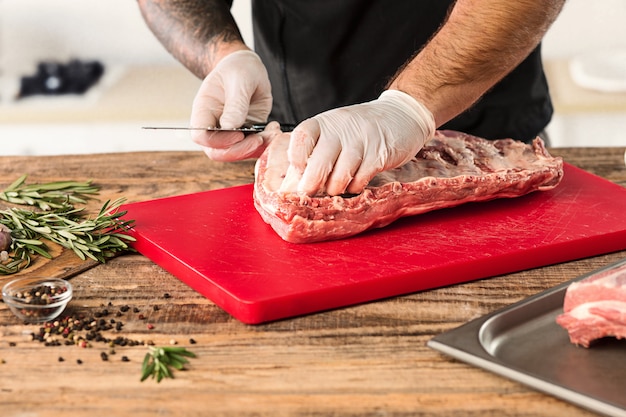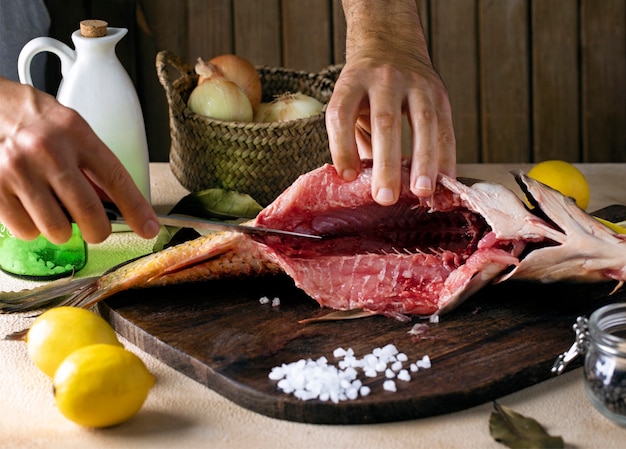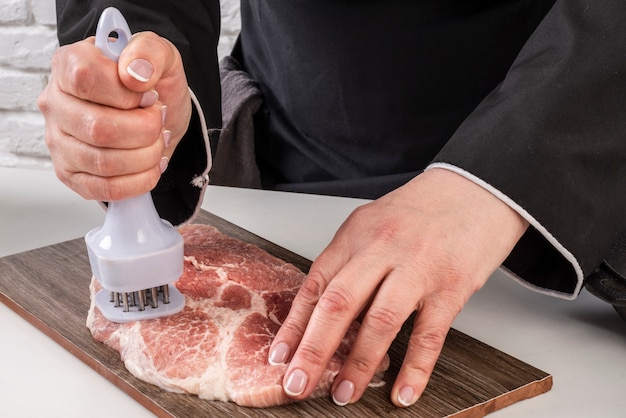Let’s talk steak, shall we? As a seasoned home cook, I've spent countless hours perfecting my steak game, and there's nothing quite like a perfectly cooked piece of beef. That beautiful crust, the tender, juicy inside, the aroma that fills the kitchen – it’s pure culinary bliss. But, I’ve had my fair share of steak mishaps – overcooked, dry, tough – you name it, I’ve done it. But through trial and error, I've finally mastered the art of cooking steak to that perfect medium doneness, and I'm excited to share my secrets with you.
Now, everyone has their steak preferences, but for me, medium is where it’s at. It's got that lovely pink center, but it's not raw. It's tender, juicy, and full of flavor. It’s the happy medium – you get that lovely, juicy texture, and the flavour is rich and intense. But achieving that perfect medium doneness is not as simple as it looks. It takes a bit of understanding about how heat affects meat, and some handy tips and tricks. So, grab your apron, let's dive in!
(Part 1) Understanding Doneness

What is Medium Doneness?
First things first, let’s get the basics sorted. Medium doneness means the steak has a beautiful pink center, but it’s not raw. The outside is cooked through, with a nice golden-brown crust. The internal temperature reaches around 145°F (63°C). When you press on it, you should feel a slight resistance, indicating the outside is cooked, while the center remains tender and juicy. It's like a perfect balance between cooked and raw, a symphony of texture and flavour.
Why Does Doneness Matter?
It’s all about the flavour and texture. Think of it this way: overcooked steak gets tough and dry, and the juices get cooked out, leaving a disappointing mouthful. On the other hand, undercooked steak can be a bit chewy, and, let's be honest, not exactly safe to eat. Medium doneness strikes that perfect balance, giving you the best of both worlds. You get that luscious, juicy texture, and the flavour is rich and intense, with the meat’s natural juices sealed in.
Doneness Levels Explained
Let's break down the different doneness levels, so you can clearly understand what you're aiming for:
- Rare: The steak is very red inside, with a cool center. It's essentially just seared on the outside, giving it a slight warm bite. This is for those who like their steak with a pronounced raw texture.
- Medium Rare: This is where the steak starts to have a hint of pink center, but it’s still quite red. It has a bit more resistance than rare, indicating the center is slightly warmer. This is a popular choice among steak lovers for its juicy and flavorful experience.
- Medium: This is our sweet spot! The center is pink, but it’s not raw, offering a balance between cooked and raw. You'll feel a bit more resistance when you press on it, signifying the internal temperature is reaching that ideal range. This is the perfect blend of tenderness and flavour.
- Medium Well: The pink center is starting to fade, and the steak has a slightly brown center. The internal temperature is getting closer to well done, and the texture starts to become a bit firmer. This is for those who prefer a less pink center, but still retain a hint of juiciness.
- Well Done: The entire steak is cooked through, with no pink center. The texture is firm and the juices have been fully cooked out. It’s a bit dry and tough, but it’s a personal preference for some.
(Part 2) choosing the right steak

Cut Matters:
Choosing the right steak is key. Not all cuts are created equal when it comes to tenderness and flavour. Here are some of my personal favorites for achieving medium doneness:
- Ribeye: This is a classic choice for a reason. It's marbled with fat, giving it a rich flavour and incredibly tender texture. It's perfect for those who love a juicy, flavorful steak.
- new york strip: This cut is leaner than ribeye, offering a bit more distinct flavour. It's perfect for grilling or pan-frying and creates a beautiful crust.
- Tenderloin: This is a super tender cut, known for its melt-in-your-mouth texture. However, it can be a bit pricey, making it ideal for special occasions.
- flank steak: This is a lean cut that’s best for marinating and grilling. It has a lot of flavour and becomes incredibly tender once cooked. It's a great option for those who enjoy a more robust, flavorful steak.
Thickness is Key:
The thickness of your steak plays a crucial role in how it cooks. Thicker steaks take longer to cook and require a lower heat to prevent overcooking the outside while the center is still raw. A good rule of thumb is to aim for steaks that are about 1.5 inches thick. You can, of course, use thinner cuts, but you'll need to adjust cooking times accordingly.
(Part 3) Preparing Your Steak

Seasoning:
Less is more when it comes to seasoning. Don't overpower the natural flavour of the steak. I prefer a simple combination of salt and freshly ground black pepper. You can also add a pinch of garlic powder or onion powder for a touch of extra flavour.
Tip: Season the steak generously right before cooking. This allows the salt to draw out moisture, creating a more flavorful steak. It also helps the spices to adhere to the surface, creating a delicious crust.
Bringing to Room Temperature:
This is a bit of a controversial topic, but I always bring my steak to room temperature before cooking. It helps the steak cook more evenly and prevents it from getting cold in the middle, which can lead to uneven cooking. Take it out of the fridge about 30 minutes before you're ready to cook. This is especially important for thicker cuts.
(Part 4) Cooking Methods
There are various ways to cook a steak, each yielding unique results. Choose the method that best suits your preferences and equipment.
Grilling:
Grilling is my personal favorite way to cook steak. It produces that lovely char on the outside and it’s perfect for outdoor entertaining. You get that smoky flavor and the beautiful grill marks that add a visual appeal to the steak. Use medium-high heat for the best results.
Pan-Frying:
Pan-frying is a great option for when you’re short on time. It's also perfect for indoor cooking. Just make sure you use a good quality pan that can handle high heat. A cast-iron skillet is a classic choice for pan-frying steak, as it heats up quickly and evenly.
reverse searing:
This is a bit more advanced, but I love reverse searing. It's the opposite of traditional grilling or pan-frying. You cook the steak in a low oven first, then sear it on the stovetop. This method ensures that the steak cooks evenly and stays incredibly juicy.
Here's how it works:
- Preheat your oven to 275°F (135°C) and cook the steak for about 1-1.5 hours, depending on thickness, until it reaches an internal temperature of 125°F (52°C) for medium doneness. This will allow the steak to cook evenly throughout.
- Once the steak is cooked to your desired internal temperature, remove it from the oven and let it rest for about 10 minutes.
- While the steak is resting, heat a cast-iron skillet or grill pan over high heat. Once the pan is smoking hot, sear the steak for 1-2 minutes per side to create a beautiful crust.
This method is a bit more time-consuming, but it's well worth it for the results. You'll have a steak that's perfectly cooked from edge to center, with a beautiful, crispy crust.
(Part 5) Cooking Times and Temperatures
Now, here’s where things can get a bit tricky. The cooking time depends on the thickness of your steak, the cut, and the cooking method you choose. You can use a meat thermometer to check the internal temperature, or you can use the “touch test” which I’ll explain later. But for a rough guideline, here are some average cooking times for medium doneness:
Steak Cooking Time Chart (Medium Doneness):
| Steak Thickness (inches) | Grilling Time (minutes per side) | Pan-Frying Time (minutes per side) | Reverse Searing Oven Time (325°F) |
|---|---|---|---|
| 1 | 4-5 | 3-4 | 15-20 |
| 1.5 | 5-6 | 4-5 | 20-25 |
| 2 | 6-7 | 5-6 | 25-30 |
Remember, these are just rough guidelines. It’s always best to check the internal temperature of the steak to ensure it’s cooked to your liking. I recommend using a meat thermometer for the most accurate results, especially for thicker cuts.
(Part 6) Checking for Doneness
Meat Thermometer:
The most reliable way to check for doneness is with a meat thermometer. Insert it into the thickest part of the steak, making sure it doesn’t touch any bone. For medium doneness, you want the internal temperature to reach 145°F (63°C). Don't panic if you see a bit of pink; that's perfectly normal. Just make sure the internal temperature is within the safe range.
The Touch Test:
If you don’t have a meat thermometer, you can try the “touch test”. This is a bit less accurate, but it can give you a general idea. Press on the centre of the steak with your finger. If it feels firm and springy, it’s medium. If it feels soft and mushy, it’s undercooked. If it feels rock-hard, it’s overcooked.
(Part 7) Resting Your Steak
Once your steak is cooked to perfection, don’t rush to cut into it! Let it rest for 5-10 minutes before slicing. This allows the juices to redistribute throughout the meat, resulting in a more tender and flavorful steak. The juices will settle back into the center, preventing them from running out when you slice it.
Tip: Cover the steak loosely with foil to keep it warm while it rests. It will help retain the heat and prevent the steak from cooling down too quickly.
(Part 8) Slicing and Serving
Slicing:
Slice the steak against the grain. This means cutting across the muscle fibres, making it easier to chew. If you slice with the grain, the steak will be tougher. Visualize the grain patterns on the steak and cut perpendicular to them.
Serving:
Serve your steak hot, with your favourite sides. I love to serve mine with roasted vegetables, mashed potatoes, or a simple salad. You can also get creative with other sides like asparagus, mushrooms, or even a side of creamy risotto.
FAQs
1. How do I prevent my steak from drying out?
The key to preventing a dry steak is to cook it at the right temperature and for the right amount of time. Overcooking is the main culprit behind dry steak. Use a meat thermometer to ensure you’re not cooking it past medium doneness, and let it rest for at least 5 minutes before slicing. This will allow the juices to redistribute and create a more tender, juicy steak.
2. What happens if I overcook my steak?
If you overcook your steak, it will become tough and dry. The juices will have been cooked out, and it won’t be as flavorful. The texture will become firm and chewy, and the natural flavors will be lost.
3. Can I cook steak in the oven?
Absolutely! You can cook steak in the oven using the reverse searing method. This involves cooking the steak in a low oven for a longer period, then searing it on the stovetop for a crispy crust. It’s a great way to ensure the steak cooks evenly and stays juicy. It's perfect for those who prefer a more hands-off approach to cooking steak.
4. What are some good marinades for steak?
There are endless possibilities when it comes to steak marinades. Here are a few popular options that add depth and flavour to your steak:
- Soy sauce, garlic, ginger, and honey: This marinade gives the steak a sweet and savory flavour, with a hint of umami. It's a great choice for those who enjoy Asian-inspired flavors.
- Olive oil, balsamic vinegar, herbs, and spices: This marinade is simple and classic, and it adds a touch of acidity to the steak, complementing its natural flavors. Use herbs like rosemary, thyme, or oregano for a fragrant and delicious result.
- Red wine, Dijon mustard, and garlic: This marinade is bold and flavorful, and it complements the steak beautifully, adding a touch of richness and depth. The acidity of the red wine helps to tenderize the steak, while the Dijon mustard adds a tangy flavor.
5. What are some good sides for steak?
You can serve your steak with almost any side you like, but here are some classic pairings that complement the rich flavors of steak:
- Roasted vegetables: Broccoli, asparagus, Brussels sprouts, and carrots all go well with steak, adding a burst of color and freshness. Roasted vegetables can be seasoned with herbs and spices for an added touch of flavor.
- Mashed potatoes: creamy mashed potatoes are the perfect comfort food pairing for steak. They offer a creamy and comforting texture that balances the richness of the steak.
- baked potato: A loaded baked potato is a hearty and satisfying side for steak, offering a warm and comforting element. Load it up with your favorite toppings like cheese, sour cream, chives, and bacon for a decadent experience.
- Salad: A simple green salad with vinaigrette dressing helps to balance out the richness of the steak. It adds a refreshing and light touch to the meal.
And there you have it, my complete guide to cooking the perfect medium-done steak. It may seem a bit daunting at first, but trust me, once you get the hang of it, you’ll be grilling up juicy, flavorful steaks in no time. Happy cooking! And remember, the key to a great steak is not just the cooking process, but the enjoyment you get from the experience. So, relax, have fun, and enjoy that delicious steak!
Everyone is watching

Corn on the Cob: The Ultimate Guide to Perfectly Cooked Ears
Healthy MealsAh, corn on the cob. Just the name evokes images of sunny days, barbecues, and that sweet, juicy flavour that ...

Perfect Pork Roast Oven Cooking Time: A Guide to Delicious Results
Healthy MealsThere's something truly satisfying about a perfectly roasted pork. The aroma alone is enough to make your mout...

Scallops: The Ultimate Guide to Perfect Cooking
Healthy MealsAh, scallops. Those delicate, sweet, and utterly delicious morsels of the sea. They hold a special place in my...

Ham Cooking Time: How Long to Bake, Smoke, or Boil a Delicious Ham
Healthy MealsAh, ham. It's a classic, isn't it? A real crowd-pleaser, especially around holidays. And when done right, it'...

Spaghetti Squash: The Ultimate Guide to Cooking and Serving
Healthy MealsRemember that time you saw spaghetti squash at the supermarket, looking all bumpy and strange, and thought, "W...
